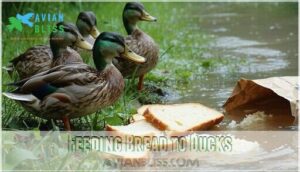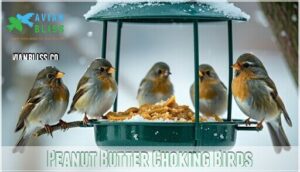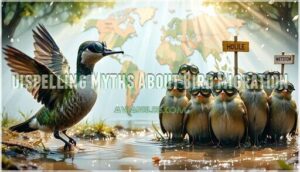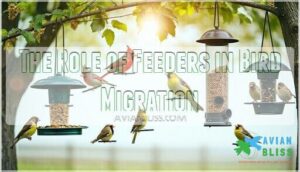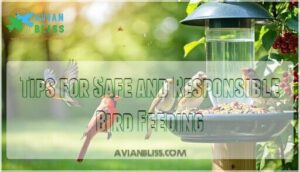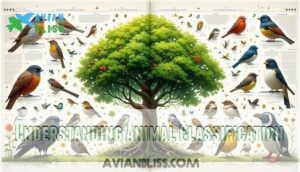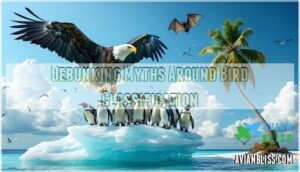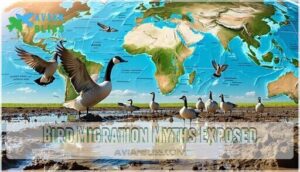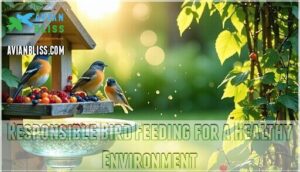This site is supported by our readers. We may earn a commission, at no cost to you, if you purchase through links.
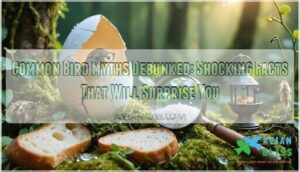
These common bird myths debunked reveal surprising truths. Bread actually lacks nutrition ducks need and can make them sick.
Most birds have excellent smell capabilities, contrary to popular belief. You don’t need to worry about rice making birds explode either – that’s completely false.
Birds handle uncooked rice just fine. Their feet won’t freeze to metal feeders thanks to special blood circulation. Peanut butter won’t choke them if spread thin.
Understanding these facts helps you make better choices for backyard birds and appreciate their remarkable abilities.
Table Of Contents
- Key Takeaways
- Separating Bird Fact From Fiction
- Common Bird Myths Debunked
- The Truth About Bird Feeding
- Bird Feeding Myths Busted
- Understanding Animal Classification
- Debunking Myths Around Bird Classification
- The Science Behind Bird Migration
- Bird Migration Myths Exposed
- Keeping Your Bird Feeders Safe and Healthy
- Responsible Bird Feeding for a Healthy Environment
- Frequently Asked Questions (FAQs)
- Are there any myths about bird migration?
- What if I find a wild bird in trouble?
- Can a wild bird injure itself in a bird cage?
- Are myths true or false?
- Why do birds puff out their feathers?
- How do birds know where they are on a trip?
- Are birds endangered by household chemicals?
- Can birds predict natural disasters?
- Do birds have better night vision than humans?
- Why do birds build nests in outdoor furniture?
- Conclusion
Key Takeaways
- You don’t need to worry about feeding rice to birds – Uncooked rice won’t explode in their stomachs like the urban myth suggests, and many wild birds already eat rice as part of their natural diet without any problems.
- Your bird feeders won’t trap birds’ feet in winter – Birds have special blood circulation that prevents their feet from freezing to metal surfaces, though you can choose wood or plastic perches for extra peace of mind.
- You can safely offer thin peanut butter to birds – This popular myth about choking hazards is completely false, and natural peanut butter actually provides essential fats and calories that help birds survive winter months.
- Your feeders won’t stop bird migration – Birds migrate based on daylight changes and genetic instincts, not food availability, so keeping feeders up year-round only provides supplemental nutrition without disrupting their natural patterns.
Separating Bird Fact From Fiction
You’ve probably heard countless stories about birds that sound believable but aren’t actually true. These common myths can mislead people and sometimes even harm the birds we’re trying to help.
*Don’t let bird myths fool you into harming the feathered friends you’re trying to help.
Common Misconceptions About Birds
You’ve probably heard tales about birds that sound too wild to be true. These bird myths and bird misconceptions persist despite scientific evidence proving otherwise.
Understanding real bird facts helps us appreciate these remarkable creatures and their actual bird behavior. Many believe birds bury their heads in sand or hibernate in mud, but these are just common myths.
Birds exhibit complex behaviors and characteristics that often get misunderstood. By learning more about fascinating bird facts, such as the unique lung system of birds that includes air sacs acting like bellows to fuel their flights, understanding the truth about birds can help foster respect for our feathered friends.
Here are three shocking truths that’ll change how you see birds:
- Bird Intelligence rivals that of primates – crows can solve puzzles and use tools
- Bird Affection is real – parrots form genuine emotional bonds with their owners
- Owl Myths about wisdom are false – they’re actually not the smartest birds around
Avian Veterinary experts confirm these facts, and contrary to Mother Abandonment myths, touching baby birds won’t make parents reject them.
Importance of Debunking Bird Myths
Countless bird myths spread false information that harms wildlife conservation efforts. Scientific accuracy matters because these misconceptions lead to poor decisions about bird care and habitat protection.
Debunking bird myths protects wildlife—accurate knowledge leads to better conservation and healthier birds.
Public education helps people make informed decisions about ethical treatment of birds. Understanding real bird facts instead of bird folklore promotes better conservation practices.
| Myth Impact | Real Consequence | Better Outcome |
|---|---|---|
| Wrong feeding habits | Sick or dependent birds | Healthy wild populations |
| Fear-based decisions | Reduced conservation support | Active habitat protection |
| Misinformation spread | Continued harmful practices | Evidence-based bird care |
Common Bird Myths Debunked
You’ve probably heard that feeding bread to ducks is harmful or that birds’ feet will freeze to metal feeders in winter.
These common beliefs about birds are actually myths that don’t match the scientific facts.
Feeding Bread to Ducks
You’ve probably tossed bread to ducks thinking you’re helping, but this common practice actually harms waterfowl health.
Bread lacks essential nutrients and causes malnutrition in ducklings.
Here are better bread alternatives for responsible feeding:
- Cracked corn and oats
- Chopped lettuce and peas
- Duck pellets from pet stores
- Small seeds like millet
- Fresh fruits cut into pieces.
These options support proper duck nutrition while protecting environmental impact.
They are a more responsible choice for feeding ducks.
Birds’ Feet Freezing to Metal Feeders
After bread myths, let’s tackle another concern: will your feathered friends get stuck on frozen metal feeders? Here’s the real scoop on Cold Feet Facts.
Birds possess amazing Circulation Adaptations that prevent freezing. Their feet have special blood vessels that maintain warmth even on icy surfaces. Metal Conductivity doesn’t trap them like we imagine.
Smart bird feeding tips:
- Choose wood or plastic Perch Material over metal
- Position bird feeders in wind-protected areas
- Remove feeders overnight during extreme cold
Peanut Butter Choking Birds
You’ve probably heard warnings about peanut butter safety and bird choking hazards, but here’s the truth: this popular bird myth is completely false.
Bird facts show that peanut butter won’t choke wild birds. Their beaks handle the consistency just fine, and it’s actually excellent for bird feeding during winter months.
Natural, smooth peanut butter provides essential fats and calories for their bird diet. Skip chunky varieties and avoid anything with salt or sweeteners.
When bird myths debunked like this one, you’ll feel confident offering this nutritious treat without worry.
Uncooked Rice Swelling in Birds’ Bellies
You’ve heard that uncooked rice will explode in a bird’s stomach like a tiny time bomb. This urban myth has zero scientific backing. Bird anatomy handles rice just fine – their digestive systems process grains naturally.
Many wild birds already eat rice in their normal diet without any issues. Rice digestion works the same way whether it’s cooked or raw.
Here’s what makes rice safe for feeding wildbirds:
- Birds’ stomachs don’t provide enough moisture for dangerous swelling
- Wild birds regularly consume various grains and seeds
- Rice breaks down gradually through normal digestive processes
- No documented cases exist of rice-related bird deaths. This fact underscores the safe digestion of rice by birds, supporting the idea that rice is a normal part of their diet.
The Truth About Bird Feeding
You’ve probably heard that bread is fine for ducks or that rice will harm birds, but these common beliefs are wrong.
The truth about bird feeding involves understanding what foods help birds thrive and which ones can actually cause harm, which is crucial for their well-being and survival.
Best Foods to Offer Birds
While bird myths often confuse what’s best for feeding birds, the truth is simple.
Your feathered visitors need variety beyond basic birdseed. Mix different seed varieties with unsalted nuts for essential nutrition. Fresh fruits provide vitamins that keep birds healthy.
Consider pre-mixed seed options for convenience.
| Food Type | Examples |
|---|---|
| Seeds | Sunflower, millet, nyjer |
| Nuts | Peanuts, almonds (unsalted) |
| Fruits | Berries, chopped apples |
| Grains | Oats, cooked rice |
| Water | Fresh, clean daily |
Bird-Safe and Toxic Foodstuffs
Through careful selection, you’ll discover that Safe Seed Mixes and Natural Peanut Butter make excellent bird food choices.
While Safe Fruit Options like apples (minus seeds) provide essential nutrients.
However, Avoiding Avocados is vital—they’re deadly to birds.
Toxic Garden Plants and chocolate also pose serious threats.
Understanding these bird myths about bird feeding protects bird health when feeding birds responsibly.
Avoiding Disease Transmission
Beyond choosing safe foods, feeder sanitation protects your backyard visitors from harmful bird diseases.
Food spoilage creates dangerous bacteria that spread quickly when bird density increases around feeders.
Disease vectors multiply fast in dirty environments, turning your good intentions into health hazards.
Clean feeders monthly with mild soap and hot water to maintain proper bird hygiene.
Remove spilled seeds and droppings immediately – they’re breeding grounds for parasites.
Water hygiene matters too, so scrub birdbaths regularly.
These bird myths about "natural immunity" don’t hold up when bird health depends on your maintenance habits.
Here’s what dirty feeders can cause:
- Salmonella outbreaks that kill entire flocks
- Eye infections spreading through bird communities
- Parasitic infestations weakening immune systems
- Respiratory diseases affecting song quality
- Fatal fungal infections from moldy seeds
Importance of Fresh Water
Clean water makes all the difference in your backyard birds’ lives. Hydration Importance can’t be overstated—dehydration weakens their immune systems quickly.
Water Quality affects everything from digestion to feather health. Bathing Benefits include parasite removal and temperature regulation.
Preventing Dehydration supports bird welfare year-round. Regular Water Source Maintenance keeps bird habits healthy, supporting bird conservation while debunking myths about low-maintenance feeding.
Bird Feeding Myths Busted
You’ve probably heard that keeping bird feeders up will stop birds from migrating south for winter.
This widespread belief is completely false, and understanding the real facts about feeders and migration will help you become a better bird caretaker, by knowing that it is a false assumption.
Dispelling Myths About Bird Migration
Understanding bird feeding myths leads us to examine migration triggers that truly drive these incredible journeys.
You’ve probably heard wild stories about bird migration that sound too crazy to believe – and you’re right to be skeptical.
Bird migration patterns aren’t influenced by your backyard feeder.
These navigation methods rely on magnetic fields and star patterns, not human handouts.
Here’s the hibernation truth behind common bird myths:
- Hummingbirds don’t hitchhike on geese during bird migration routes – they fly solo across continents
- Most birds don’t hibernate in mud – only poorwills truly enter hibernation
- Storm resilience helps birds navigate turbulent weather using lightweight bodies and strong wings
Feeder impact on bird migration facts remains minimal compared to instinctual drives.
The Role of Feeders in Bird Migration
Many worry that bird feeders disrupt migration timing, but this feeder impact concern isn’t supported by science.
Birds migrate based on daylight changes and instinct, not food availability. Supplemental feeding provides only 10-25% of their diet.
Rather than creating dependency risks or migration disruption, feeders actually help feeding birds build energy reserves for their journeys.
| Migration Factor | Feeder Influence |
|---|---|
| Daylight changes | No impact |
| Genetic instinct | No impact |
| Weather patterns | No impact |
| Food availability | Minimal impact |
| Bird migration patterns | Unchanged |
Tips for Safe and Responsible Bird Feeding
Safe bird feeding starts with feeder hygiene—clean feeders monthly with hot soapy water.
Offer food variety like seeds, grains, and nuts while avoiding toxic foods like chocolate.
Make certain water access with fresh sources nearby.
Plant native plants for natural nutrition.
Position bird feeders away from windows and cats.
These bird feeding practices create healthier environments for feeding birds year-round.
Understanding Animal Classification
You’ve probably wondered if birds are actually animals or belong to their own separate group.
The truth is that birds are animals with specific traits like feathers, beaks, and warm-blooded bodies that place them in the animal kingdom’s Class Aves.
Characteristics of Birds
Feathers make birds unique in the animal kingdom – no other creature has them.
You’ll find their beaks are made of keratin, growing continuously throughout their lives.
Their warm-blooded physiology keeps them active in cold weather, while specialized bird senses help them navigate and hunt.
Bird characteristics include hollow bones for lightweight flight, powerful wing muscles, and remarkable bird coloration.
These myths debunked facts show birds’ incredible adaptations for survival.
Birds Versus Animals: Analyzing Differences
You might wonder what separates birds from other animals beyond just having wings.
Avian Characteristics like feathers, beaks, and hard-shelled eggs create clear Physiological Contrasts with Mammalian Traits such as fur and live birth.
This Evolutionary Divergence shaped birds’ lightweight bones and high metabolic rates for flight.
While bird myths often get debunked, the real differences between birds and other animals involve fascinating Habitat Adaptations that help them thrive in diverse environments.
Similarities Between Birds and Other Animals
You’ll find birds share more with other animals than you’d expect.
Like mammals, birds are warm-blooded with complex social behaviors and remarkable intelligence.
Their evolutionary adaptations mirror those found across species – from communication patterns to parenting instincts.
These physiological traits and behavioral parallels reveal our shared ancestry, proving that common bird myths about their uniqueness are often debunked by science.
Debunking Myths Around Bird Classification
You’ve probably heard someone say that bats are birds or wonder if penguins really count as birds since they can’t fly.
These common mistakes about bird classification happen because people focus on obvious traits like flight or appearance instead of understanding what actually makes an animal a bird.
Ostriches, Penguins, and Flamingos
Now that you understand birds belong to a specific classification, let’s tackle some wild misconceptions about three fascinating species. You’ve probably heard people question whether ostriches, penguins, and flamingos are "real" birds. These myths persist because these creatures look so different from typical backyard songbirds.
Ostrich Behavior might seem un-birdlike – they can’t fly and stand eight feet tall. But they’re absolutely birds with feathers, beaks, and hollow bones. Penguins waddle on land yet glide underwater like aquatic missiles. Their Penguin Habitats range from Antarctica to the Galápagos Islands. Flamingo Diets involve filter-feeding through specialized curved bills.
Here’s what makes these Flightless Birds genuinely avian:
- Bird Adaptations include feathers for insulation and display
- They lay hard-shelled eggs like all birds
- Warm-blooded metabolism keeps them active
- Unique beaks suit their specific feeding needs
- Hollow bones reduce body weight despite size
These debunked bird myths prove appearances deceive – ostriches, penguins, and flamingos remain true birds.
Bats: Mammals or Birds?
Many people confuse bats with birds due to their flight ability, but this classification confusion stems from overlooking key mammal traits.
Bats give birth to live young, nurse babies, and have hair – not feathers like birds.
These evolutionary history differences debunked common bird myths.
While both groups fly, bat characteristics clearly place them among mammals, not birds.
Common Misconceptions About Bird Classification
While bats clearly belong to mammals due to their fur and live births, bird classification myths persist everywhere.
You’ve probably heard wild stories about ostrich behavior or assumed all penguins live in Antarctica. These bird myths stem from unique appearances that confuse people about proper bird identification.
Here’s what makes bird species truly part of Class Aves:
- Feathers covering their bodies
- Beaks instead of teeth
- Warm-blooded metabolism
- Egg-laying reproduction
- Hollow bones for flight
Understanding avian traits helps separate penguin habitats facts from fiction, and highlights the importance of proper bird identification and knowing what makes birds part of the Aves class.
The Science Behind Bird Migration
You’ve probably wondered how birds know exactly when and where to fly thousands of miles without getting lost.
Scientists now use GPS tracking and satellite technology to understand that birds navigate using Earth’s magnetic field, sunlight, stars, and landmarks rather than the old theories that suggested they simply followed food sources or weather patterns.
The old theories are being replaced by new understanding of how birds actually navigate, using Earth’s magnetic field and other cues to find their way.
Historical Theories on Bird Migration
Ancient civilizations crafted wild theories about bird migration that seem laughable today. Aristotle thought redstarts transformed into robins, while Biblical bird references suggested divine intervention.
Medieval migration ideas included hibernation underwater, and 18th-century observations led to moon travel theories.
| Era | Theory | Reasoning |
|---|---|---|
| Ancient Greek | Bird transformation | Seasonal species changes |
| Medieval | Underwater hibernation | Birds vanished completely |
| 18th Century | Lunar migration | No other explanation |
Early migration beliefs reveal humanity’s creative problem-solving when faced with mysterious whereabouts.
Modern Understanding of Bird Migration
Modern GPS tracking reveals bird migration secrets we never imagined.
You’ll discover that birds navigate using Earth’s magnetic fields, not just instinct.
Migration triggers depend on daylight changes, while climate change shifts traditional routes.
Advanced bird migration research shows remarkable storm resilience – birds don’t just survive turbulent weather, they’ve evolved incredible bird migration adaptations for these bird migration challenges.
Bird Migration Myths Exposed
You’ve probably heard stories about tiny hummingbirds riding on the backs of geese during long migrations, or birds disappearing into mud to hibernate through winter.
These tales sound fascinating, but science shows us that bird migration works very differently than these old myths suggest.
Hummingbirds Hitchhiking on Geese
You’ve probably heard the charming bird tale that hummingbirds catch rides on geese during migration.
This bird myth couldn’t be more wrong.
Their tiny aerial athletes don’t need hitchhiking help – their bird aerodynamics are perfectly designed for solo journeys.
Unlike goose behavior flying in formation, hummingbird flight patterns are independent.
Their migration methods involve traveling thousands of miles alone, fueled by hummingbird nectar stops along the way.
Bird legends often underestimate these remarkable flyers, with their ability to complete such journeys without assistance, showcasing their remarkable endurance and migration methods.
Birds Hibernating in Mud
You’ve probably heard stories about swallows disappearing into muddy riverbanks each winter, but this bird myths tale couldn’t be further from reality.
The Mud Hibernation Truth reveals that swallows don’t actually burrow underground – they migrate thousands of miles instead.
While some birds do enter Bird Torpor States during cold weather, swallows aren’t among them.
Here’s what really happens with bird behavior during winter:
- Swallows build mud nests but never hibernate in mud
- Only certain Species Mud Hibernation occurs in poorwills, not swallows
- Bird migration patterns were misunderstood before modern tracking technology debunked these myths
Keeping Your Bird Feeders Safe and Healthy
You might think that keeping bird feeders clean is just about appearances, but dirty feeders can actually spread dangerous diseases among your feathered visitors.
Regular cleaning with mild soap and hot water prevents harmful bacteria buildup and keeps your backyard birds healthy year-round.
Best Practices for Bird Feeding
Now that we’ve cleared up migration myths, let’s talk smart bird feeding practices.
Position feeders near shrubs for quick escapes but away from windows.
Offer diverse, safe foods like sunflower seeds and nyjer – skip bread and chocolate.
Clean feeders weekly with hot soapy water for proper feeder hygiene.
Provide fresh water year-round.
These bird feeding practices support balanced diets while debunking harmful bird myths.
Preventing Disease Transmission
Feeder hygiene prevents disease vectors from spreading bird flu and other bird diseases among your backyard visitors.
Clean feeders monthly with mild soap and hot water, removing droppings and spoiled food. Water sanitation matters too—refresh birdbaths regularly to prevent bacteria buildup.
Food spoilage creates breeding grounds for harmful microorganisms, especially in humid weather. High bird density around dirty feeders increases transmission risks.
Don’t let bird health myths fool you—proper cleaning protects both wild birds and your family from avian diseases.
Keeping Feeders Clean and Well-Maintained
Beyond stopping disease transmission, proper feeder hygiene keeps your backyard visitors healthy and happy.
Clean bird feeders monthly using mild dish soap and hot water – this simple cleaning solution eliminates harmful bacteria. Replace old seed regularly and check for wear that might harbor germs.
Consider using a dedicated feeder cleaner for superior hygiene. A consistent maintenance schedule prevents bird diseases from spreading through your feeding station.
- Monthly deep cleaning: Use warm soapy water to scrub away bacteria buildup
- Fresh seed rotation: Replace old or moldy seeds to maintain quality nutrition
- Material impact check: Inspect feeders for cracks where germs can hide
Responsible Bird Feeding for a Healthy Environment
You can support bird health and protect the environment by choosing the right foods and creating safe feeding spaces.
Fresh water and bird-safe foods like seeds, grains, and certain fruits help birds thrive while keeping toxic substances away from their habitat.
Importance of Fresh Water and Bird-Safe Foodstuffs
Clean feeders make happy birds. Water Quality matters more than you think – stagnant water spreads disease faster than gossip. Change your bird baths weekly and scrub them down regularly. Feeder Hygiene prevents deadly outbreaks that can wipe out entire flocks.
Safe Foods keep your backyard visitors thriving. Dietary Variety beats boring seed mixes every time. Skip the Toxic Foods like chocolate and avocado – they’re bird killers.
| Safe Options | Dangerous Items |
|---|---|
| Fresh seeds, nuts | Chocolate, caffeine |
| Clean water daily | Moldy grain |
| Suet, dried fruit | Apple seeds |
| Cooked rice, oats | Avocado, onions |
Smart bird feeding debunks harmful bird myths.
Creating a Bird-Friendly Environment
Beyond just setting up feeders, you can transform your yard into a true bird paradise.
Native vegetation provides natural food sources while water sources like shallow dishes attract diverse species.
Using eco-friendly chemicals protects birds from harmful toxins.
- Colorful native wildflowers swaying in gentle breezes
- Crystal-clear water rippling in morning sunlight
- Dense shrubs offering cozy bird nests and shelter
- Chemical-free gardens where birds safely forage
Frequently Asked Questions (FAQs)
Are there any myths about bird migration?
You’ve probably heard some tall tales about our feathered friends’ journeys.
Hummingbirds don’t hitchhike on geese, and feeders won’t stop migration.
Birds follow daylight changes and instincts, not your backyard buffet.
What if I find a wild bird in trouble?
If you spot an injured wild bird, don’t touch it immediately.
Contact local wildlife rehabilitators or animal control first.
They’ll guide you safely.
Keep pets away and observe from distance until help arrives.
Can a wild bird injure itself in a bird cage?
Like a free spirit trapped in a small room, a wild bird in your cage faces serious risks.
You’ll see panic-induced injuries from frantic wing-flapping, broken feathers, and stress-related health problems that can prove fatal.
Are myths true or false?
Myths are false beliefs that spread despite lacking evidence.
You’ve probably heard bird myths like "rice kills birds" or "touching baby birds makes parents abandon them."
These aren’t true – they’re just persistent misconceptions, and it’s essential to understand that they are false beliefs.
Why do birds puff out their feathers?
Like tiny feather duvets, birds puff their plumage to trap warm air close to their skin during cold weather.
You’ll also see this behavior when they’re trying to appear larger to intimidate threats or attract mates.
How do birds know where they are on a trip?
Birds navigate using Earth’s magnetic field, sunlight, stars, and landmarks.
They’re equipped with internal compasses that detect magnetic fields, plus they memorize visual cues like rivers and mountains during their incredible journeys, using these tools to navigate with a form of internal compass.
Are birds endangered by household chemicals?
Yes, many household chemicals pose serious risks to birds.
You’ll want to avoid aerosols, non-stick cookware fumes, and harsh cleaners around feathered friends.
Switch to eco-friendly alternatives to keep your birds safe and healthy.
Can birds predict natural disasters?
Some birds sense natural disasters through changes in air pressure, sound frequencies, or vibrations.
While they can’t predict events like humans forecast weather, their heightened senses often alert them to danger before it happens, which can be considered an ability to sense natural disasters.
Do birds have better night vision than humans?
Most birds don’t see better than you at night.
Only owls have superior night vision due to their large eyes and special adaptations.
Regular songbirds actually struggle more in darkness than humans do.
Why do birds build nests in outdoor furniture?
Ever wonder why feathered friends crash your patio party?
You’ve got prime real estate!
Your outdoor furniture offers perfect shelter, protection from predators, and cozy nooks that mimic natural nesting spots birds seek for raising their young.
Conclusion
Knowledge is power in the context of bird care.
These common bird myths debunked show how misinformation can harm our feathered friends.
You now understand that bread isn’t nutritious for ducks, birds won’t choke on thin peanut butter, and rice doesn’t cause harm.
Your bird feeders are safe from frozen feet, and migration patterns follow science, not folklore.
Armed with these facts, you can make informed decisions that truly benefit backyard birds while creating a healthier environment for wildlife, and with complete concepts in mind, you are better equipped to care for them.

